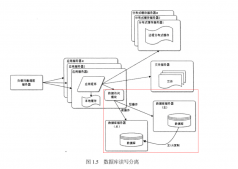EhCache 是一個純Java的進程內(nèi)緩存框架,具有快速、精干等特點,是Hibernate中默認(rèn)的CacheProvider。
ehcache提供了多種緩存策略,主要分為內(nèi)存和磁盤兩級,所以無需擔(dān)心容量問題。
spring-boot是一個快速的集成框架,其設(shè)計目的是用來簡化新Spring應(yīng)用的初始搭建以及開發(fā)過程。該框架使用了特定的方式來進行配置,從而使開發(fā)人員不再需要定義樣板化的配置。
由于spring-boot無需任何樣板化的配置文件,所以spring-boot集成一些其他框架時會有略微的不同。
1.spring-boot是一個通過maven管理的jar包的框架,集成ehcache需要的依賴如下
|
1
2
3
4
5
6
7
8
9
|
<dependency> <groupId>org.springframework</groupId> <artifactId>spring-context-support</artifactId></dependency><dependency> <groupId>net.sf.ehcache</groupId> <artifactId>ehcache</artifactId> <version>2.8.3</version></dependency> |
具體pom.xml文件如下
|
1
2
3
4
5
6
7
8
9
10
11
12
13
14
15
16
17
18
19
20
21
22
23
24
25
26
27
28
29
30
31
32
33
34
35
36
37
38
39
40
41
42
43
44
45
46
47
48
49
50
51
52
53
54
55
56
57
58
59
60
61
62
63
64
65
66
67
68
69
70
71
72
73
74
75
76
77
78
79
80
81
82
83
84
85
86
87
88
|
<?xml version="1.0" encoding="UTF-8"?><project xmlns="http://maven.apache.org/POM/4.0.0" xmlns:xsi="http://www.w3.org/2001/XMLSchema-instance" xsi:schemaLocation="http://maven.apache.org/POM/4.0.0 http://maven.apache.org/xsd/maven-4.0.0.xsd"> <modelVersion>4.0.0</modelVersion> <groupId>com.lclc.boot</groupId> <artifactId>boot-cache</artifactId> <version>0.0.1-SNAPSHOT</version> <!-- Inherit defaults from Spring Boot --> <parent> <groupId>org.springframework.boot</groupId> <artifactId>spring-boot-starter-parent</artifactId> <version>1.1.3.RELEASE</version> </parent> <dependencies> <dependency> <groupId>org.springframework.boot</groupId> <artifactId>spring-boot-starter-web</artifactId> </dependency> <dependency> <groupId>org.springframework.boot</groupId> <artifactId>spring-boot-starter-data-jpa</artifactId> </dependency> <dependency> <groupId>org.springframework.boot</groupId> <artifactId>spring-boot-starter-thymeleaf</artifactId> </dependency> <dependency> <groupId>mysql</groupId> <artifactId>mysql-connector-java</artifactId> </dependency> <dependency> <groupId>com.google.guava</groupId> <artifactId>guava</artifactId> <version>17.0</version> </dependency> <dependency> <groupId>org.springframework</groupId> <artifactId>spring-context-support</artifactId> </dependency> <dependency> <groupId>net.sf.ehcache</groupId> <artifactId>ehcache</artifactId> <version>2.8.3</version> </dependency> </dependencies> <dependencyManagement> <dependencies> </dependencies> </dependencyManagement> <build> <plugins> <plugin> <groupId>org.springframework.boot</groupId> <artifactId>spring-boot-maven-plugin</artifactId> </plugin> </plugins> </build> <repositories> <repository> <id>spring-snapshots</id> <url>http://repo.spring.io/snapshot</url> <snapshots> <enabled>true</enabled> </snapshots> </repository> <repository> <id>spring-milestones</id> <url>http://repo.spring.io/milestone</url> </repository> </repositories> <pluginRepositories> <pluginRepository> <id>spring-snapshots</id> <url>http://repo.spring.io/snapshot</url> </pluginRepository> <pluginRepository> <id>spring-milestones</id> <url>http://repo.spring.io/milestone</url> </pluginRepository> </pluginRepositories></project> |
2.使用ehcache,我們需要一個ehcache.xml來定義一些cache的屬性。
|
1
2
3
4
5
6
7
8
9
10
11
|
<?xml version="1.0" encoding="UTF-8"?><ehcache xmlns:xsi="http://www.w3.org/2001/XMLSchema-instance" xsi:noNamespaceSchemaLocation="http://ehcache.org/ehcache.xsd" updateCheck="false"> <diskStore path="java.io.tmpdir/Tmp_EhCache" /> <defaultCache eternal="false" maxElementsInMemory="1000" overflowToDisk="false" diskPersistent="false" timeToIdleSeconds="0" timeToLiveSeconds="600" memoryStoreEvictionPolicy="LRU" /> <cache name="demo" eternal="false" maxElementsInMemory="100" overflowToDisk="false" diskPersistent="false" timeToIdleSeconds="0" timeToLiveSeconds="300" memoryStoreEvictionPolicy="LRU" /></ehcache> |
解釋下這個xml文件中的標(biāo)簽。
(1).diskStore: 為緩存路徑,ehcache分為內(nèi)存和磁盤兩級,此屬性定義磁盤的緩存位置。參數(shù)解釋如下:
- user.home – 用戶主目錄
- user.dir – 用戶當(dāng)前工作目錄
- java.io.tmpdir – 默認(rèn)臨時文件路徑
(2).defaultCache:默認(rèn)緩存策略,當(dāng)ehcache找不到定義的緩存時,則使用這個緩存策略。只能定義一個。
(3).cache:自定緩存策略,為自定義的緩存策略。參數(shù)解釋如下:
- cache元素的屬性:
- name:緩存名稱
- maxElementsInMemory:內(nèi)存中最大緩存對象數(shù)
- maxElementsOnDisk:硬盤中最大緩存對象數(shù),若是0表示無窮大
- eternal:true表示對象永不過期,此時會忽略timeToIdleSeconds和timeToLiveSeconds屬性,默認(rèn)為false
- overflowToDisk:true表示當(dāng)內(nèi)存緩存的對象數(shù)目達(dá)到了maxElementsInMemory界限后,會把溢出的對象寫到硬盤緩存中。注意:如果緩存的對象要寫入到硬盤中的話,則該對象必須實現(xiàn)了Serializable接口才行。
- diskSpoolBufferSizeMB:磁盤緩存區(qū)大小,默認(rèn)為30MB。每個Cache都應(yīng)該有自己的一個緩存區(qū)。
- diskPersistent:是否緩存虛擬機重啟期數(shù)據(jù)
- diskExpiryThreadIntervalSeconds:磁盤失效線程運行時間間隔,默認(rèn)為120秒
- timeToIdleSeconds: 設(shè)定允許對象處于空閑狀態(tài)的最長時間,以秒為單位。當(dāng)對象自從最近一次被訪問后,如果處于空閑狀態(tài)的時間超過了timeToIdleSeconds屬性值,這個對象就會過期,EHCache將把它從緩存中清空。只有當(dāng)eternal屬性為false,該屬性才有效。如果該屬性值為0,則表示對象可以無限期地處于空閑狀態(tài)
- timeToLiveSeconds:設(shè)定對象允許存在于緩存中的最長時間,以秒為單位。當(dāng)對象自從被存放到緩存中后,如果處于緩存中的時間超過了 timeToLiveSeconds屬性值,這個對象就會過期,EHCache將把它從緩存中清除。只有當(dāng)eternal屬性為false,該屬性才有效。如果該屬性值為0,則表示對象可以無限期地存在于緩存中。timeToLiveSeconds必須大于timeToIdleSeconds屬性,才有意義
- memoryStoreEvictionPolicy:當(dāng)達(dá)到maxElementsInMemory限制時,Ehcache將會根據(jù)指定的策略去清理內(nèi)存。可選策略有:LRU(最近最少使用,默認(rèn)策略)、FIFO(先進先出)、LFU(最少訪問次數(shù))。
SpringBoot支持很多種緩存方式:redis、guava、ehcahe、jcache等等。
說明下redis和ehcache的區(qū)別:
Redis:屬于獨立的運行程序,需要單獨安裝后,使用Java中的Jedis來操縱。因為它是獨立,所以如果你寫個單元測試程序,放一些數(shù)據(jù)在Redis中,然后又寫一個程序去拿數(shù)據(jù),那么是可以拿到這個數(shù)據(jù)的。,
ehcache:與Redis明顯不同,它與java程序是綁在一起的,java程序活著,它就活著。譬如,寫一個獨立程序放數(shù)據(jù),再寫一個獨立程序拿數(shù)據(jù),那么是拿不到數(shù)據(jù)的。只能在獨立程序中才能拿到數(shù)據(jù)。
3.將ehcache的管理器暴露給spring的上下文容器,
|
1
2
3
4
5
6
7
8
9
10
11
12
13
14
15
16
17
18
19
20
21
22
23
24
|
@Configuration// 標(biāo)注啟動了緩存@EnableCachingpublic class CacheConfiguration { /* * ehcache 主要的管理器 */ @Bean(name = "appEhCacheCacheManager") public EhCacheCacheManager ehCacheCacheManager(EhCacheManagerFactoryBean bean){ return new EhCacheCacheManager (bean.getObject ()); } /* * 據(jù)shared與否的設(shè)置,Spring分別通過CacheManager.create()或new CacheManager()方式來創(chuàng)建一個ehcache基地. */ @Bean public EhCacheManagerFactoryBean ehCacheManagerFactoryBean(){ EhCacheManagerFactoryBean cacheManagerFactoryBean = new EhCacheManagerFactoryBean (); cacheManagerFactoryBean.setConfigLocation (new ClassPathResource ("conf/ehcache-app.xml")); cacheManagerFactoryBean.setShared (true); return cacheManagerFactoryBean; }} |
@Configuration:為spring-boot注解,主要標(biāo)注此為配置類,優(yōu)先掃描。
@Bean:向spring容器中加入bean。
至此所有的配置都做好了,通過spring-boot進行集成框架就是這么簡單。
4.使用ehcache
使用ehcache主要通過spring的緩存機制,上面我們將spring的緩存機制使用了ehcache進行實現(xiàn),所以使用方面就完全使用spring緩存機制就行了。
具體牽扯到幾個注解:
@Cacheable:負(fù)責(zé)將方法的返回值加入到緩存中,參數(shù)3
@CacheEvict:負(fù)責(zé)清除緩存,參數(shù)4
參數(shù)解釋:
- value:緩存位置名稱,不能為空,如果使用EHCache,就是ehcache.xml中聲明的cache的name
- key:緩存的key,默認(rèn)為空,既表示使用方法的參數(shù)類型及參數(shù)值作為key,支持SpEL
- condition:觸發(fā)條件,只有滿足條件的情況才會加入緩存,默認(rèn)為空,既表示全部都加入緩存,支持SpEL
- allEntries:CacheEvict參數(shù),true表示清除value中的全部緩存,默認(rèn)為false
不多說,直接上代碼:
|
1
2
3
4
5
6
7
8
9
10
11
12
13
14
15
16
17
18
19
20
21
22
23
24
25
26
27
28
29
30
31
32
33
34
35
36
37
38
39
40
41
42
43
44
45
46
|
@Servicepublic class CacheDemoServiceImpl implements CacheDemoService { /** * 緩存的key */ public static final String THING_ALL_KEY = "\"thing_all\""; /** * value屬性表示使用哪個緩存策略,緩存策略在ehcache.xml */ public static final String DEMO_CACHE_NAME = "demo"; @CacheEvict(value = DEMO_CACHE_NAME,key = THING_ALL_KEY) @Override public void create(Thing thing){ Long id = getNextId (); thing.setId (id); data.put (id, thing); } @Cacheable(value = DEMO_CACHE_NAME,key = "#thing.getId()+'thing'") @Override public Thing findById(Long id){ System.err.println ("沒有走緩存!" + id); return data.get (id); } @Cacheable(value = DEMO_CACHE_NAME,key = THING_ALL_KEY) @Override public List<Thing> findAll(){ return Lists.newArrayList (data.values ()); } @Override @CachePut(value = DEMO_CACHE_NAME,key = "#thing.getId()+'thing'") @CacheEvict(value = DEMO_CACHE_NAME,key = THING_ALL_KEY) public Thing update(Thing thing){ System.out.println (thing); data.put (thing.getId (), thing); return thing; } @CacheEvict(value = DEMO_CACHE_NAME) @Override public void delete(Long id){ data.remove (id); } } |
5.只需要通過注解在service層方法上打注解便可以使用緩存,在find**上存入緩存,在delete**,update**上清除緩存。
Cache注解詳解
@CacheConfig:主要用于配置該類中會用到的一些共用的緩存配置。在這里@CacheConfig(cacheNames = "users"):配置了該數(shù)據(jù)訪問對象中返回的內(nèi)容將存儲于名為users的緩存對象中,我們也可以不使用該注解,直接通過@Cacheable自己配置緩存集的名字來定義。
@Cacheable:配置了findByName函數(shù)的返回值將被加入緩存。同時在查詢時,會先從緩存中獲取,若不存在才再發(fā)起對數(shù)據(jù)庫的訪問。該注解主要有下面幾個參數(shù):
- value、cacheNames:兩個等同的參數(shù)(cacheNames為Spring 4新增,作為value的別名),用于指定緩存存儲的集合名。由于Spring 4中新增了@CacheConfig,因此在Spring 3中原本必須有的value屬性,也成為非必需項了
- key:緩存對象存儲在Map集合中的key值,非必需,缺省按照函數(shù)的所有參數(shù)組合作為key值,若自己配置需使用SpEL表達(dá)式,比如:@Cacheable(key = "#p0"):使用函數(shù)第一個參數(shù)作為緩存的key值,更多關(guān)于SpEL表達(dá)式的詳細(xì)內(nèi)容可參考官方文檔
- condition:緩存對象的條件,非必需,也需使用SpEL表達(dá)式,只有滿足表達(dá)式條件的內(nèi)容才會被緩存,比如:@Cacheable(key = "#p0", condition = "#p0.length() < 3"),表示只有當(dāng)?shù)谝粋€參數(shù)的長度小于3的時候才會被緩存,若做此配置上面的AAA用戶就不會被緩存,讀者可自行實驗嘗試。
- unless:另外一個緩存條件參數(shù),非必需,需使用SpEL表達(dá)式。它不同于condition參數(shù)的地方在于它的判斷時機,該條件是在函數(shù)被調(diào)用之后才做判斷的,所以它可以通過對result進行判斷。
- keyGenerator:用于指定key生成器,非必需。若需要指定一個自定義的key生成器,我們需要去實現(xiàn)org.springframework.cache.interceptor.KeyGenerator接口,并使用該參數(shù)來指定。需要注意的是:該參數(shù)與key是互斥的
- cacheManager:用于指定使用哪個緩存管理器,非必需。只有當(dāng)有多個時才需要使用
- cacheResolver:用于指定使用那個緩存解析器,非必需。需通過org.springframework.cache.interceptor.CacheResolver接口來實現(xiàn)自己的緩存解析器,并用該參數(shù)指定。
除了這里用到的兩個注解之外,還有下面幾個核心注解:
@CachePut:配置于函數(shù)上,能夠根據(jù)參數(shù)定義條件來進行緩存,它與@Cacheable不同的是,它每次都會真是調(diào)用函數(shù),所以主要用于數(shù)據(jù)新增和修改操作上。它的參數(shù)與@Cacheable類似,具體功能可參考上面對@Cacheable參數(shù)的解析
@CacheEvict:配置于函數(shù)上,通常用在刪除方法上,用來從緩存中移除相應(yīng)數(shù)據(jù)。除了同@Cacheable一樣的參數(shù)之外,它還有下面兩個參數(shù):
- allEntries:非必需,默認(rèn)為false。當(dāng)為true時,會移除所有數(shù)據(jù)
- beforeInvocation:非必需,默認(rèn)為false,會在調(diào)用方法之后移除數(shù)據(jù)。當(dāng)為true時,會在調(diào)用方法之前移除數(shù)據(jù)。
以上就是本文的全部內(nèi)容,希望對大家的學(xué)習(xí)有所幫助,也希望大家多多支持服務(wù)器之家。
原文鏈接:http://www.cnblogs.com/lic309/p/4072848.html















